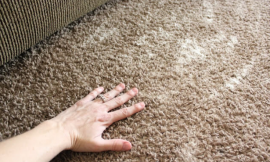
Did you know that up to 50% of indoor mold thrives in garages and storage spaces? These areas, often neglected, can trap moisture and promote the growth of harmful mold spores. Whether you're storing seasonal decorations, sports gear, or garden tools, understanding how to prevent mold growth in garages and storage areas is crucial for maintaining a safe and healthy home! In this guide, we’ll explore practical strategies to keep your storage areas mold-free and tackle this common home issue together.
Understanding Mold and Its Causes
Mold is a type of fungus that can grow in various environments, particularly in places with excessive moisture. There are several types of mold, including black mold, green mold, and white mold, each with its own characteristics and potential health impacts. In garages and storage areas, mold thrives in damp conditions, making it crucial to understand its causes.
Common sources of moisture in these spaces often include leaks from pipes or roofs, humidity from the environment, and even standing water from improper drainage. Additionally, environmental conditions such as inadequate ventilation and high humidity levels can promote mold growth. Keeping your garage or storage area dry and well-ventilated is key to minimizing mold-related issues.
Importance of Garage and Storage Area Maintenance
Regular cleaning in your garage or storage area goes a long way in preventing mold growth. When these spaces are cluttered and dirty, it's easier for moisture to accumulate and create an ideal environment for mold. Regular organizational efforts help ensure that air can circulate freely, reducing humidity levels.
Ventilation plays a significant role in mold prevention. Ensuring there are adequate airflow and ventilation systems in place can help lower humidity and inhibit mold growth. Additionally, understanding how temperature and humidity fluctuate in your garage can aid in maintaining a mold-free environment. Ideally, temperatures should be kept consistent, and humidity levels should be controlled to below 60%.
Effective Moisture Control Strategies
One effective method to combat moisture is to install dehumidifiers. These devices can help maintain the ideal humidity levels, particularly in areas prone to dampness. Tips for using dehumidifiers include selecting the right size for your space and regularly emptying the water reservoir.
Insulation is another essential strategy for regulating temperature and reducing moisture. Proper insulation can keep your garage warmer in winter and cooler in summer, reducing the chances of condensation forming. Furthermore, ensuring proper drainage in and around parking areas can prevent water from accumulating and creating a moisture problem.
Best Practices for Organizing Your Storage Space
When it comes to organizing your storage area, utilizing plastic bins and containers can be a smart move. These not only help prevent dampness from reaching your stored items but also make it easier to keep your space tidy.
Incorporating smart shelving ideas can further improve airflow throughout your garage. For example, consider using slatted shelves which allow air to circulate freely around your belongings. Additionally, regularly rotating stored items can help avoid stagnation and ensure that nothing is left to gather moisture over time.
Regular Inspections and Maintenance Checks
Setting a regular cleaning schedule is vital for effective mold prevention. This routine should include not only cleaning but also inspecting key areas for mold and moisture. Focus on corners, under shelves, and around pipes—places that may be prone to dampness.
If you come across mold during your inspections, it’s important to know how to tackle it. Start by cleaning the affected area with appropriate cleaning solutions and tools. For larger infestations, consider more thorough removal methods, which may include discarding affected materials.
Selecting Mold-Resistant Products
When looking to prevent mold, consider using mold-resistant paints and coatings on the walls of your garage and storage areas. These special formulations can help inhibit mold growth and keep your spaces looking fresh.
Choosing the right materials for storage is equally important. Opt for materials that are less susceptible to moisture accumulation, such as treated wood or metal shelves. Moreover, having the right tools for mold detection—like moisture meters and mold testing kits—can help you stay ahead of potential problems.
DIY vs. Professional Mold Remediation
When dealing with mold, it's crucial to know when to tackle the problem yourself and when it's best to call in professionals. If you notice a small amount of mold in an isolated area, you may opt for a DIY approach with appropriate cleaning solutions. However, for larger infestations or ongoing mold issues, it might be wise to consult a professional.
Recognizing the signs that necessitate professional intervention is important. If the mold covers a large area or if you experience health issues related to mold exposure, seeking expert help is advisable. While the costs may seem high, the long-term benefits of professional remediation can save you from larger repairs and potential health risks down the line.
Conclusion
Preventing mold growth in garages and storage areas is not just about keeping your belongings safe—it's about maintaining a healthy home environment! By implementing these effective prevention strategies, you're taking the first step toward a mold-free space. Regular inspections and maintenance will keep mold at bay. Ready to safeguard your garage? Take action today, and feel free to share your experiences with us!







